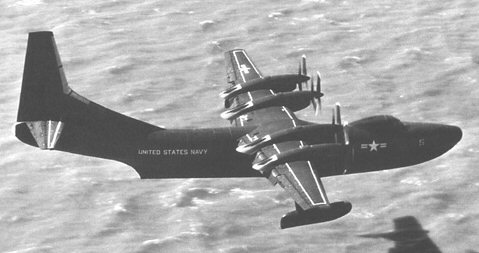- R3Y Tradewind
infobox Aircraft
name = R3Y Tradewind
type = transport flying boat
logo =
manufacturer =Convair 
caption = R3Y-1 Tradewind low over San Francisco Bay near NAS Alameda
designer =
first flight = 1954 (R3Y-1)
introduction = 1956 (R3Y-1)
retired = 1958
status = Retired
primary user =United States Navy
more users =
produced =
number built = 11 (R3Y) & 2 (P5Y)
unit cost =
developed from =
variants with their own articles =The Convair R3Y Tradewind was an American 1950s
turboprop -poweredflying boat designed and built byConvair .Design and development
Convair received a requirement from the
United States Navy in1945 for a large flying-boat using the new technology developed during the war, especially thelaminar flow wing and the developingturboprop technology. Their response, the Model 117 was a large, high-wing flying boat withAllison T-40 engines driving six-bladedcontra-rotating propellers , a slender high-lift wing with fixed floats, and a sleek body with a single-step hull. The Navy ordered two prototypes on27 May 1946. Designated XP5Y-1 the first aircraft first flew on18 April 1950 atSan Diego . In August the aircraft set a turboprop endurance record of 8 hours 6 minutes. The Navy decided not to proceed with the patrol boat version but directed that the design should be developed into a passenger and cargo aircraft.Work continued despite the loss of one of the XP5Y-1s in a non-fatal accident on July 1953. The transport and cargo version was designated the R3Y-1 Tradewind and first flew on
25 February 1955. Major changes were the removal of all armament and of the tailplane dihederal, the addition of a 10ft (3.05m) port-side access hatch and redesigned engine nacelles to accept improved T40-A-10 engines. Cabin sound proofing and airconditioning were added and pressurised accommodation for 103 passengers or 24 tons of cargo. As a medivac aircraft 92 stretcher cases could be carried.The first two built were in P5Y configuration, armed with 8,000 lb (3,600 kg) of stores (bombs, mines, depth charges, torpedoes) and 5 pairs of 20 mm cannon in fore and aft side emplacements and a tail turret. The next five were built as R3Y-1 aircraft, intended for troop transport and inflight refuelling tanker service. The final six were built as the R3Y-2 variant with a lifting nose and high cockpit (similar to modern-day eyes to the
C-5 Galaxy 's nose and cockpit) for heavier transport and landing-ship duties.Eleven aircraft were built, of which six were front-loading R3Y-2 aircraft with a hinged nose and high cockpit; they were intended to be a "Flying LST" (
landing craft ). In practice, it was discovered that it was almost impossible for the pilots to hold the aircraft steady and nose on to the beach while the aircraft was loaded or unloaded. [Ginter, Steve, "Convair XP5Y-1 & R3Y-1/2 Tradewind," Simi Valley, CA, Steve Ginter, 1996, pg. 94, ISBN 0-942612-34-5] The aircraft were converted into tankers for theinflight refuelling role. They had a short service life because of the insoluble unreliability of theirAllison T40 turboprop engines, a fate common to most early turboprop-powered aircraft, such as the DouglasA2D Skyshark attack aircraft.Operational service
The R3Y set a transcontinental seaplane record of 403 mph in 1954 by utilising the speed of high-altitude jetstream winds. This record still stands.
After service trials the aircraft were delivered to US Navy transport squadron VR-2 on
31 March 1956. Problems with the engine/propeller combination led to the ending of Tradewind operations and the unit was disbanded on16 April 1958.The six R3Y-2s were converted into four-point in-flight tankers using the probe-and-drogue method. In September 1956 one example was the first aircraft to successfully refuel four others simultaneously in flight in
1956 , refuelling fourF9F Cougar s.The program was halted after thirteen aircraft were built, the reason being the unreliability of the Allison T-40 turboprops. The crash of one of the two XP5Y-1 aircraft was judged due to catastrophic engine failure; when little progress was being made with the engine problems, the Navy halted the program. Subsequently three more aircraft were lost through engine failures, and the Navy gave up on the T-40 and aircraft powered by it. All the P5Y and R3Y aircraft were grounded in
1958 and subsequently broken up.Variants
;XP5Y-1:Prototype patrol flying boat, two built.;R3Y-1:Transport aircraft for the
United States Navy with side loading door, 5 built.;R3Y-2:Assault transport aircraft for the USN with shorter nose incorporating an upward-opening loading door, later converted to four-point tankers for probe-and-drogue operations, six built.Operators
*
United States
**United States Navy pecifications (R3Y)
aircraft specifications
plane or copter?=plane
jet or prop?=propcrew=
capacity=
length main=139 ft 8 in
length alt=42.26 m
span main=145 ft 9 in
span alt=44.42 m
height main=51 ft 5 in
height alt=15.68 m
area main=2,102 ft²
area alt=195.3 m²
airfoil=
empty weight main=71,824 lb
empty weight alt=32,579 kg
loaded weight main=145,500 lb
loaded weight alt=66,000 kg
useful load main=
useful load alt=
max takeoff weight main=165,000 lb
max takeoff weight alt=74,800 kgengine (prop)=
Allison T-40
type of prop=turboprop s
number of props=4 sets of 3-blades
power main=8 engines in 4 pairs, each with 5,100 hp
power alt=3,800 kW
max speed main=337 kt
max speed alt=403 mph, 624 km/h
cruise speed main=
cruise speed alt=
never exceed speed main=
never exceed speed alt=
stall speed main=
stall speed alt=
range main=2,420 nm
range alt=2,785 mi, 4,482 km
ceiling main=39,700 ft
ceiling alt=12,100 m
climb rate main= ft/min
climb rate alt= m/s
loading main=69.22 lb/ft²
loading alt=338 kg/m²
power/mass main=0.14 hp/lb
power/mass alt=230 W/kgarmament=
ee also
aircontent
sequence=
related=
similar aircraft=
lists=
*List of cargo aircraft
*List of seaplanes and flying boats
*List of military aircraft of the United States (naval) see also=
References
Wikimedia Foundation. 2010.
